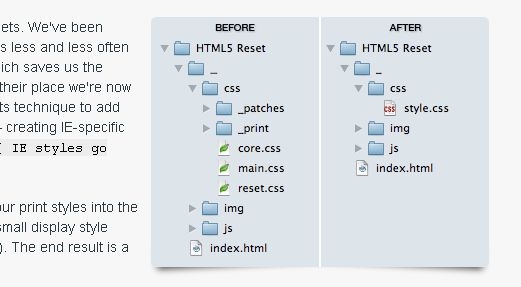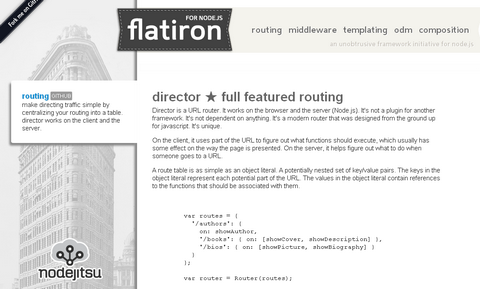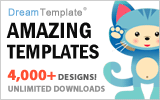JSARToolKit is an augmented reality library for JavaScript. It’s an open source library released under the GPL. This is a JavaScript port of FLARToolKit, operating on canvas images and video element contents.
HTML5 Rocks has shared an article: Writing Augmented Reality Application using JSARToolKit, which tells you how to use the JSARToolKit library with the WebRTC getUserMedia API to do augmented reality applications on the web. For rendering, he is using WebGL due to the increased performance it offers. It shows a demo application that puts a 3D model on top of an augmented reality marker in webcam video.

Requirements: JavaScript Framework
Demo: http://www.html5rocks.com/en/tutorials/webgl/jsartoolkit_webrtc/
License: GPL License
Developers these days are spoiled with choice when it comes to selecting an MV* framework for structuring and organizing JavaScript web apps. Backbone, Spine, Ember.js (SproutCore 2.0), JavaScriptMVC… The list of new and stable solutions goes on and on, but just how do you decide on which to use in a sea of so many options?
To help solve this problem, TodoMVC was created – a project which offers the same Todo application implemented using MVC concepts in most of the popular JavaScript MV* frameworks of today. Solutions look and feel the same, have a common feature set, and make it easy for you to compare the syntax and structure of different frameworks, so you can select the one you feel the most comfortable with.

Requirements: JavaScript MV* Frameworks
Demo: http://addyosmani.github.com/todomvc/
License: License Free
Hogan.js is a 2.5k JavaScript templating engine developed at Twitter. You can use it as a part of your asset packager to compile templates ahead of time or include it in your browser to handle dynamic templates.
Hogan.js was developed against the mustache test suite. That means you get variables, sections, lambdas, partials, filters, and everything else you’ve come to expect from mustache templating but only much, much faster.

Requirements: JavaScript supported browsers
Demo: http://twitter.github.com/hogan.js/
License: Apache License
Bootstrap 2.0 has just released with a lot of new features, rewritten documentation, and use cases to test with the addition of media queries.
They have also added some new components like progress bars, customizable gallery thumbnails and split buttons. Another great new feature are the new glyph icons, that you can use to style your buttons and menus.
Now there are total 12 custom jQuery Plugins for you to enhance Bootstrap. It includes, Modals, Tooltips, Dropdowns, Scrollspy, Carousel and more. All in all a huge update with many exciting features.

Requirements: –
Demo: http://twitter.github.com/bootstrap/
License: Apache License v2.0
Many of us start every HTML project with the same set of HTML and CSS files. We’ve been using these files for a long time. Now that modern browsers are starting to support some of the really useful parts of HTML5 and CSS3, it’s time for our best practices to catch up.
HTML5 Reset is a simple set of best practices to get web projects off on the right foot. It includes A style sheet designed to strip initial files from browsers, Analytics and jQuery snippets in place, Meta tags ready for population, Empty mobile and print style sheets, IE-specific classes for simple CSS-targeting, iPhone/iPad/iTouch icon snippets and lots of other keen stuff.

Requirements: –
Demo: http://html5reset.org/
License: BSD License
Pokki is an application platform for creating desktop applications using HTML5, CSS3 and JavaScript. Pokki uses Chromium internally, meaning layout and rendering is powered by WebKit and JavaScript is powered by V8 – giving you the latest and greatest of HTML5.
Beyond the standard HTML5 features you are accustomed to, Pokki gives you a set special JavaScript APIs and events, a window for your application called a popup, and an invisible background window for notifications.
Pokki also takes care of all the “desktop†stuff you don’t want to think about, like memory management and installers, so you can focus purely on application development. Would you like to have Gmail on your desktop with instant notifications for new mail, quick account switching and a beautiful interface? Or stay notified and quickly access everything you love about Facebook, without having to open a browser? Pokki brings awesome apps to your desktop too!

Source: http://www.pokki.com/
Batman.js is a framework for building rich single-page browser applications. It is written in CoffeeScript and its API is developed with CoffeeScript in mind, but of course you can use plain old JavaScript too.
It got a stateful MVC architecture, a powerful binding system, routable controller actions, pure HTML views, toolchain support built on node.js and cake. The APIs are heavily inspired by Rails and designed to make Rails devs feel right at home. It has been tested on Chrome, Safari 4+, Firefox 3+, and IE 7+ for compatibility.

Requirements: –
Demo: http://batmanjs.org/
License: MIT License
Ember.js is a JavaScript framework for creating ambitious web applications by eliminating boilerplate and providing a standard application architecture.
Ember.js, like some other modern JavaScript frameworks, works a little differently. Instead of the majority of your application’s logic living on the server, an Ember.js application downloads everything it needs to run in the initial page load. That means that while your user is using your app, she never has to load a new page and your UI responds quickly to their interaction.
One advantage of this architecture is that your web application uses the same REST API as your native apps or third-party clients. Back-end developers can focus on building a fast, reliable, and secure API server, and don’t have to be front-end experts, too.

Requirements: JavaScript Framework
Demo: http://www.emberjs.com/
License: License Free
Foundation is a rock-solid, responsive framework for rapidly prototyping and iterating into production code. It includes tons of great tools and elements that’ll get you up and running in no time.
Within global.css you’ll find The Grid, a layout framework that works on mobile devices, small screens and full-on modern desktops. It’s a twelve column, semi-liquid, mobile-scaling grid of awesomeness that you’re gonna love. It even supports arbitrary nesting.
Foundation includes dozens of styles and elements to help you quickly put together clickable prototypes, that can then be adapted and styled into polished production code. Forms, buttons, tabs, all kinds of good stuff. Foundation is MIT-licensed and absolutely free to use.
You should also look at Twitter Bootstrap Toolkit we mentioned earlier too. It includes base CSS and HTML for typography, forms, buttons, tables, grids, navigation, and etc.

Requirements: –
Demo: http://foundation.zurb.com/
License: MIT License
It’s difficult to get consensus on how much or how little a framework should do. Flatiron is an unobtrusive framework initiative for node.js. No one agrees on frameworks. Flatiron’s approach is to package simple to use yet full featured components and let developers subtract or add what they want.
Flatiron promotes code organization and sustainability by clearly separating development concerns. Each component works elegantly with or without its counterparts. Many of the components work the same in the browser as they do on the server. This is the motivation behind flatiron.

Requirements: Node.js
Demo: http://flatironjs.org/
License: License Free













